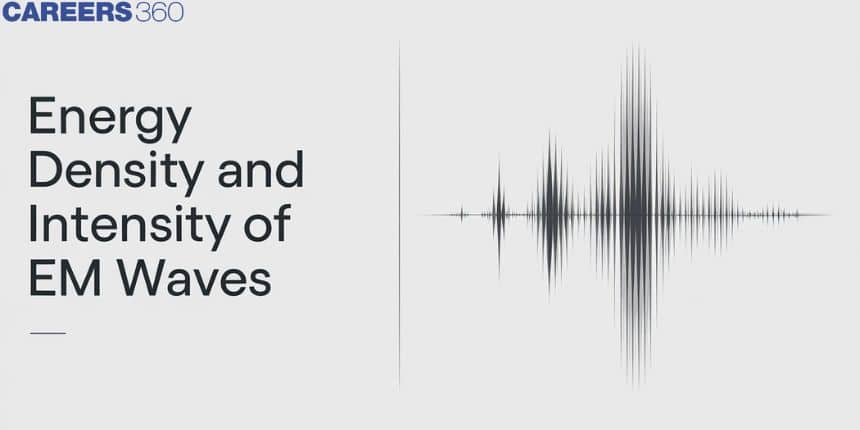Energy Density And Intensity Of EM Waves
Energy density and intensity of electromagnetic (EM) waves are fundamental concepts in physics that describe the distribution and impact of energy in wave form. Energy density refers to the amount of energy stored in a given volume of space, while intensity is the power per unit area carried by the wave. Understanding these principles is crucial in real-life applications such as wireless communication, where signal strength and quality depend on the intensity of EM waves. Additionally, in solar energy technology, the energy density of sunlight determines the efficiency of solar panels. This article explores the mechanics of energy density and intensity in EM waves and their significance in everyday technology and scientific advancements.
JEE Main/NEET 2027: Physics Important Formulas for Class 10
NEET 2025: Mock Test Series | Syllabus | High Scoring Topics | PYQs
JEE Main: Study Materials | High Scoring Topics | Preparation Guide
JEE Main: Syllabus | Sample Papers | Mock Tests | PYQs
- Energy Density and Intensity of EM Waves
- Solved Examples Based on Energy Density and Intensity of EM Waves
- Hence, the answer is option (4).
- Summary

Energy Density and Intensity of EM Waves
Energy density and intensity of electromagnetic (EM) waves are fundamental concepts in physics that describe the distribution and transfer of energy through space. Energy density refers to the amount of energy stored per unit volume in an EM wave, while intensity is the power per unit area carried by the wave.
Electromagnetic waves carry both energy and momentum.
So, the energy density in the electric field is $=\frac{1}{2} \epsilon_0 E^2$
energy density in a magnetic field is $=\frac{B^2}{2 \mu_0}$
since, electromagnetic wave contains both electric and magnetic field, so, total energy density is
$
\mu=\frac{1}{2} \epsilon_o E^2+\frac{B^2}{2 \mu_o}
$
$E=$ Electric field
$B=$ Magnetic field
$\epsilon_o=$ Permittivity of vacuum
$\mu_0=$ permeability of vacuum
Recommended Topic Video
Solved Examples Based on Energy Density and Intensity of EM Waves
Example 1: The dimension of $\left[\frac{B^2}{2 \mu_0}\right]_1$, where B is the magnetic field and $\mu_0$ is the permeability of vacuum, is :
1) $M L^2 T^{-2}$
2) $M L^{-1} T^{-2}$
3) $M L T^{-2}$
4) $M L^2 T^{-1}$
Solution:
The energy density of Electromagnetic wave $=\frac{1}{2} \frac{B^2}{\mu_o}$
$
\text { So }\left[\frac{B^2}{2 \mu_0}\right]=\left[\frac{\text { Energy }}{\text { Volume }}\right]=\left[\frac{M L^2 T^{-2}}{L^3}\right]=M L^{-1} T^{-2}
$
Hence, the answer is option (2).
Example 2: An electromagnetic wave in a vacuum has electric and magnetic fields $\vec{E}$ $\vec{B}$ which are always perpendicular to each other. The direction of polarization is given by $\vec{X}$ and that of wave propagation by $\vec{k}$. Then :
1) $\vec{X} \| \vec{B}$ and $\vec{k} \| \vec{B} \times \vec{E}$
2) $\vec{X} \| \vec{E}$ and $\vec{k} \| \vec{E} \times \vec{B}$
3) $\vec{X} \| \vec{B}$ and $\vec{k} \| \vec{E} \times \vec{B}$
4) $\vec{X} \| \vec{E}$ and $\vec{k} \| \vec{B} \times \vec{E}$
Solution:
The direction of polarization is parallel to a magnetic field, $\therefore \overrightarrow{\mathrm{X}} \| \overrightarrow{\mathrm{E}}$
The direction of wave propagation is parallel to $\overrightarrow{\mathrm{E}} \times \overrightarrow{\mathrm{B}}$
$
\therefore \overrightarrow{\mathrm{k}} \| \overrightarrow{\mathrm{E}} \times \overrightarrow{\mathrm{B}}
$
Hence, the answer is option (2).
Example 3: Suppose that the intensity of the laser is $\left(\frac{315}{\pi}\right) \frac{W}{m^2}$. The RMS electric field, in units $\frac{V}{m}$ associated with this source, is close to the nearest integer $\qquad$ Take
$
\epsilon_0=8.85 \times 10^{-12} \mathrm{C}^2 \mathrm{Nm}^{-2}, \mathrm{C}=3 \times 10^2 \mathrm{~m} / \mathrm{s}
$
1) 194
2) 275
3) 378
4) 467
Solution:
$\begin{aligned} & \because I=\frac{1}{2} \varepsilon_0 E_0^2 c \\ & \Rightarrow E_0=\sqrt{\frac{21}{\varepsilon_0 c}} \\ & \therefore E_{r m s}=\frac{E_0}{\sqrt{2}}=\sqrt{\frac{1}{\varepsilon_{0 c}}} \\ & =\sqrt{\frac{315}{\pi} \times \frac{1}{8.86 \times 10^{-12} \times 3 \times 10^8}} \\ & =194\end{aligned}$
Example 4: If the magnetic field component of the electromagnetic wave is $\vec{B}=\left(2.0 \times 10^{-7} \mathrm{wb} / \mathrm{m}^2\right) \sin \left[2 \pi\left(\frac{x}{18 \mathrm{~m}}-\frac{t}{6.0 \times 10^{-8} \mathrm{~s}}\right)\right] \hat{\mathrm{j}}$ then the intensity of the electromagnetic wave is (approximately)
1) 5
2)4
3)3
4)6
Solution:
The average intensity of electromagnetic waves is
$I=\frac{1}{2} \frac{B_o^2}{\mu_0} c=\frac{1}{2} \times \frac{\left(2 \times 10^{-7}\right)^2}{\left(4 \pi \times 10^{-7}\right)} \times 3 \times 10^8=5$
Hence, the answer is option (1).
Example 5: A plane electromagnetic wave of intensity $6 \frac{W}{m^2}$ strikes a small mirror area $40 \mathrm{~cm}^2$ held perpendicular to the approaching wave. The momentum transferred by the wave to the Mirror is one second and will be
1) $6.4 \times 10^{-7} \mathrm{~kg} \cdot \frac{\mathrm{m}}{\mathrm{s}^2}$
2) $4.8 \times 10^{-8} \mathrm{~kg} \cdot \frac{\mathrm{m}}{\mathrm{s}^2}$
3) $3.2 \times 10^{-9} \mathrm{~kg} \cdot \frac{\mathrm{m}}{\mathrm{s}^2}$
4) $1.6 \times 10^{-10} \mathrm{~kg} \cdot \frac{\mathrm{m}}{\mathrm{s}^2}$
Solution:
The momentum transferred by the wave to the Mirror is one second (for a completely reflecting surface) is $P=\frac{2 U}{c}$
$P=\frac{2 U}{c}=\frac{2 S_{\text {avg }} A}{c}=\frac{2 \times 6 \times 40 \times 10^{-4}}{3 \times 10^8}=1.6 \times 10^{-10}$
Hence, the answer is option (4).
Summary
The concepts of energy density and intensity of electromagnetic (EM) waves are crucial in understanding how energy is distributed and transferred through space. Energy density refers to the energy stored per unit volume, while intensity is the power per unit area carried by the wave. These principles are essential in applications such as wireless communication, where signal strength depends on wave intensity, and solar energy technology, which relies on the energy density of sunlight for efficient power generation. Solved examples highlight calculations related to these concepts, demonstrating their importance in both theoretical and practical contexts.
Also Read
13 Nov'24 11:10 AM
13 Nov'24 11:04 AM
12 Nov'24 11:55 PM
12 Nov'24 11:15 PM
12 Nov'24 10:04 PM
26 Sep'24 10:28 AM
26 Sep'24 10:26 AM
26 Sep'24 10:23 AM